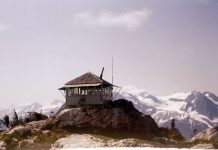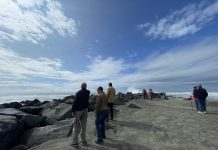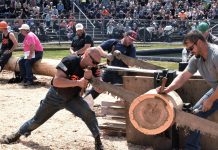Found throughout the Lummi Reservation and Whatcom County, story poles by Lummi House of Tears Carvers are also part of a larger national story. For more than 20 years, their Totem Pole Journey has transported poles across the country to advocate for Indigenous rights and environmental causes.
The House of Tears started in the 1980s with Jewell James and the late Ken Cooper, Vernon Johnson, and Dale James. Today, Jewell James carves with another brother, Doug James, and other assistants.
“The idea was to be able to access old growth trees out of the National Forest for cultural purposes,” says James. The group also wanted to carve totem poles and story poles to place on the Lummi Indian Reservation and off-reservation locations, to share the culture for reservation youth but also with others living elsewhere. “It was the late Vernon Johnson’s idea to start locating poles off-reservation, which he was adamant about.”
Since then, the Totem Pole Journey has used local forms of traditional art for national awareness-raising.
“It became a way to do environmental messaging in a friendly way,” James says. “People will come out to see a story pole because they don’t normally see them in other parts of the country.”
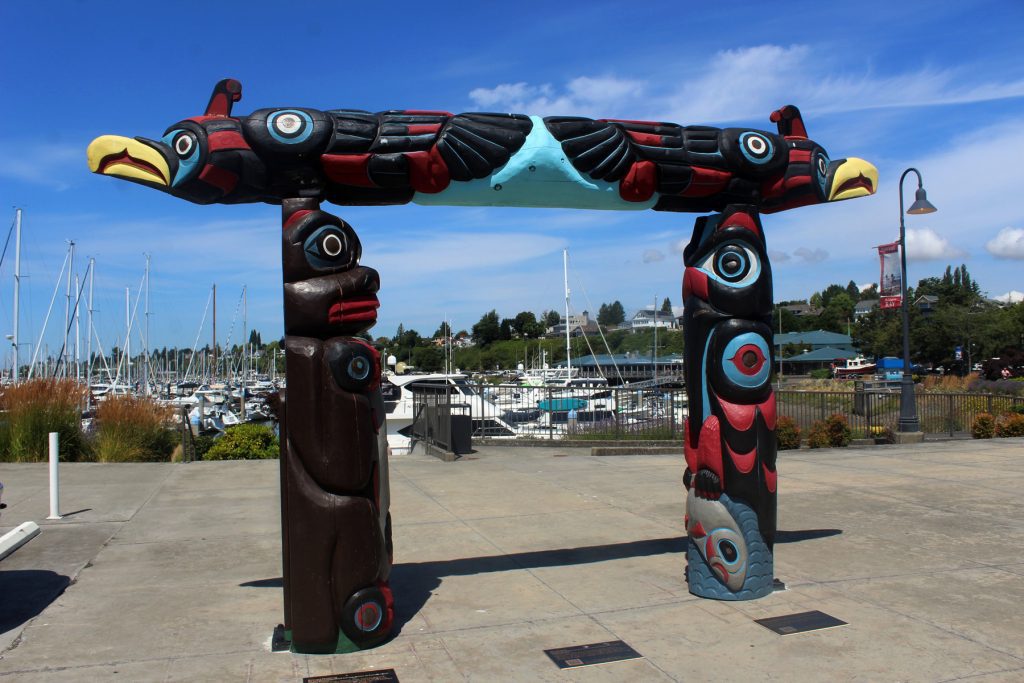
Totem Pole Journey
The Totem Pole Journey started after the September 11 attacks, which coincided with James’ time advocating for treaty rights and tribal sovereignty in Washington, D.C.
“We decided we were going to put a pole up in Sterling Forest for the children that lost their families in the Twin Towers, as a gift,” says James. “That led us to put another pole up at Shanksville, Pennsylvania, where Flight 93 crashed. Then publicity led to us doing an arch where Flight 77 hit the Pentagon.”
Over decades, the House of Tears have mobilized support for movements such as the Sioux and Beaver Lake Cree’s protests for treaty rights against tar sands mining, Free Leonard Peltier, and protections of religious freedoms.
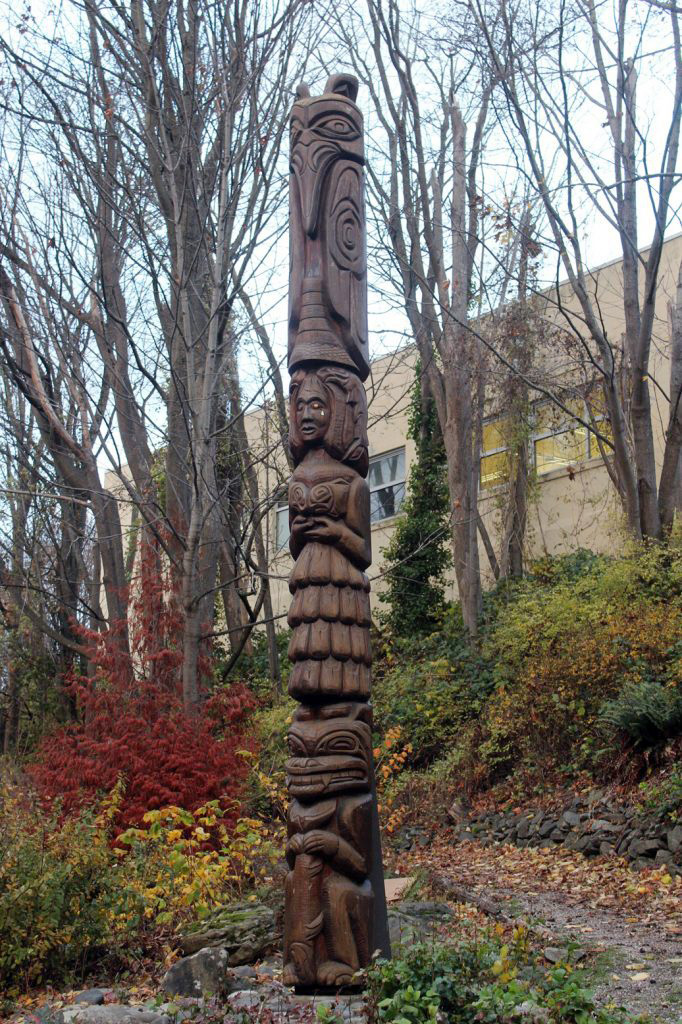
“Those first three years of real activism in regards to off-reservation totem poles became a message system,” James says. “We decided to keep on going with the idea that we can deliver totem poles to communities where we’re calling for citizens, organizations, church groups, environmental groups, and various political activists that come together for protecting the earth.”
The House of Tears responds to centuries of oppression and colonialization of Native Americans, much of it within living memory. The Lummi Nation has experienced religious persecution, such as federal raids for owning eagle feathers.
“I think we’re one of the few entities that are nationally and internationally trying to advocate the power of our culture — and that our culture tells the story,” says James. “And the story is our relationship with the world around us.” James was actively involved in the United Nations’ Declaration and Rights of Indigenous Peoples and drafted the original paper President Obama used to accept the U.N. declaration.
Local Story Poles
“They call it politics,” James says of the Totem Pole Journey. “But for us, it’s more of a spiritual obligation to protect the world around us.” Carvings promote cultural renewal following periods of termination under the Religious Crimes Code of 1883.
“Down here we have a story telling us how the salmon came,” says James. “We have stories about how things changed around us. And so, in our House of Tears Carvers, we try to keep those stories in mind. It’s like writing a book, or a chapter; you look at a totem pole and there’s three or four stories tied to it.” It’s James’ hope that someone will come up behind the carvers and write out all the stories for each of the poles, so that 50 years from now kids will know what was intended.
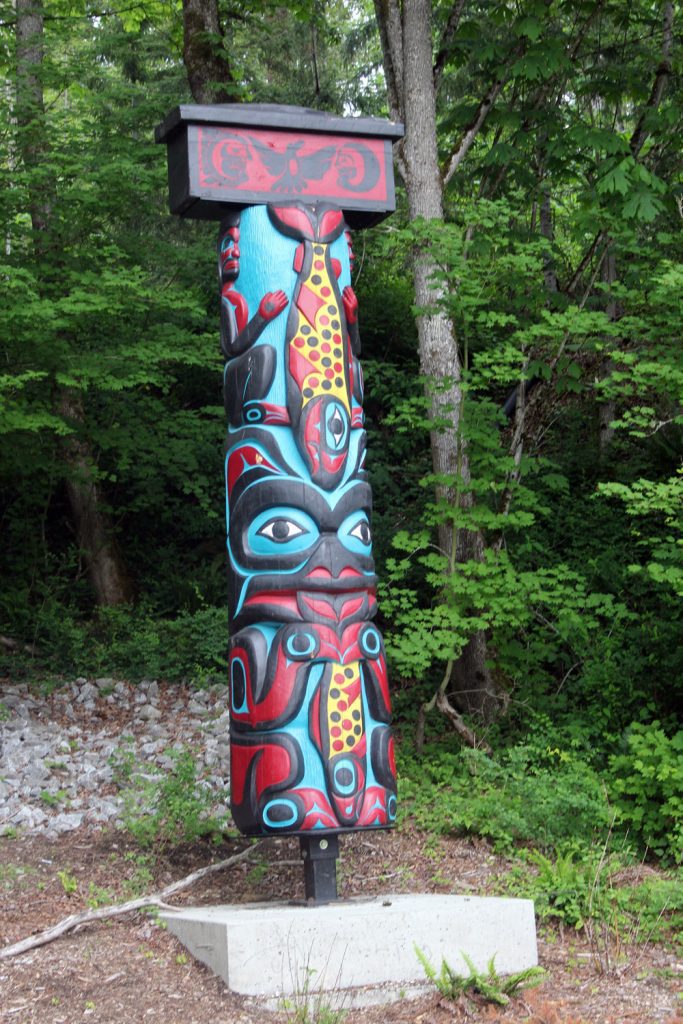
The House of Tears created the 2006 totem at Whatcom Falls Park memorializing the victims of the 1999 Olympic Pipeline explosion. Their other local works include the Salmon Woman Totem at Maritime Heritage Park and Double Thunderbird pole at Bellwether Plaza.
The story poles, which use commercial paints, recall traditional carvings with dyes from clays and plants. They now use old-growth logs, which lack the knots of second growth.

Carving Out a Future
House of Tears Carvers has carried on with the support of tribal leaders and long-term partners.
“Freddie Lane has worked on media outreach,” James says. “He’s working with the Children of the Setting Sun right now, working with his cousin Darrell. But Freddie would do a lot of contacts with the tribes.”
House of Tears social media document recent works, such as support for the National Native American Boarding School Healing Coalition.
“Every tribe in the United States has been impacted by the boarding school damages; we hope to do a totem pole that will help raise awareness and financial support from the tribes, especially the gaming tribes,” says James. “We’re hoping they would do more donating to the Coalition so they can begin dealing with not only identifying the surviving former students that may have been damaged, but also dealing with the intergenerational stress and trauma that impacted Indian country.”
For the House of Tears, the story of promoting unity and healing through cultural expression continues.






